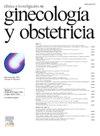通过皮肤病变诊断孕妇患有转移性肾癌:病例报告描述
IF 0.1
Q4 OBSTETRICS & GYNECOLOGY
Clinica e Investigacion en Ginecologia y Obstetricia
Pub Date : 2024-10-05
DOI:10.1016/j.gine.2024.100999
引用次数: 0
摘要
导言妊娠期癌症约影响到千分之一的孕妇,其中肾细胞癌(RCC)在泌尿道最为常见。在2.8%-6.8%的病例中,RCC可发生皮肤转移。由于诊断和治疗方面的挑战可能会影响孕产妇和新生儿的预后,因此对妊娠期 RCC 采用多学科方法至关重要。体格检查发现右侧下腹部和右侧大腿分别有两个红斑橘皮样结节,所有结节均与深面粘连,未触及淋巴结肿大。诊断、治疗干预和结果切除皮肤活检及免疫组化和分子研究提示乳头状肾癌皮肤转移。核磁共振显示有多个转移性植入物和淋巴结病变。尽管医生建议患者终止妊娠以接受靶向治疗,但患者仍选择继续妊娠。第 31 周时,由于疾病进展导致产妇临床症状恶化,患者接受了剖腹产手术。产后开始接受卡博替尼(Cabozantinib)的肿瘤治疗。结论妊娠期癌症诊断是一项复杂的挑战,平衡母体预后和胎儿健康至关重要。强调多学科方法和早期咨询可优化临床和情绪管理。本文章由计算机程序翻译,如有差异,请以英文原文为准。
Diagnóstico de cáncer renal metastásico en gestante a través de lesiones cutáneas: descripción de un caso clínico
Introduction
Gestational cancer affects approximately 1 in 1,000 pregnant women, with renal cell carcinoma (RCC) being the most common in the urinary tract. RCC dissemination can include cutaneous metastases in 2.8-6.8% of cases. A multidisciplinary approach to RCC during pregnancy is crucial due to diagnostic and therapeutic challenges that can impact maternal and neonatal outcomes.
Symptoms and Clinical Findings
A 15-week pregnant woman presents with asymptomatic cutaneous lesions for 4 months. Physical examination reveals two erythematous-violaceous nodules in the right hypochondrium and two in the right thigh, all adherent to deep planes and without palpable lymphadenopathy.
Diagnosis, Therapeutic Intervention, and Results
Excisional skin biopsy with immunohistochemical and molecular studies suggests cutaneous metastasis of papillary-pattern renal carcinoma. Nuclear magnetic resonance reveals multiple metastatic implants and lymphadenopathies. Despite recommendations to terminate pregnancy for targeted therapy, the patient chooses to continue. At week 31, a cesarean section is performed due to maternal clinical deterioration from disease progression. Oncologic treatment with Cabozantinib begins postpartum. Six months later, the patient remains stable with significant lesion improvement.
Conclusion
Diagnosing cancer during pregnancy presents a complex challenge, balancing maternal prognosis with fetal health is critical. Emphasizing a multidisciplinary approach and early consultation optimizes both clinical and emotional management.
求助全文
通过发布文献求助,成功后即可免费获取论文全文。
去求助
来源期刊

Clinica e Investigacion en Ginecologia y Obstetricia
OBSTETRICS & GYNECOLOGY-
CiteScore
0.20
自引率
0.00%
发文量
54
期刊介绍:
Una excelente publicación para mantenerse al día en los temas de máximo interés de la ginecología de vanguardia. Resulta idónea tanto para el especialista en ginecología, como en obstetricia o en pediatría, y está presente en los más prestigiosos índices de referencia en medicina.
 求助内容:
求助内容: 应助结果提醒方式:
应助结果提醒方式:


